Tennessee is home to numerous turtle species, ranging from vulnerable species like the Bog turtle to aquatic species such as spiny softshells and Map turtles. You can find many turtles along the banks of the Harpeth River and other areas of Tennessee. Unfortunately, some turtle species are endangered and threatened in this area, but it’s good to see people coming together to protect these adorable creatures.
In this article, we are going to have a detailed look at all the various turtle species in Tennessee, including what’s unique about them in appearance, lifespan, size, diet, reproduction, location and conservation status. If you are a Tennessee herpetology enthusiast or want to adopt a native turtle, this list should help you know where to start.
There is 18 Native turtles in Tennessee
- Bog Turtle
- Alligator Snapping Turtle
- Common Musk Turtle
- Stripe-necked Musk turtle
- Eastern Mud Turtle
- Three-toed Box turtle
- Eastern River Cooter
- False Map Turtles
- Northern Map Turtle
- Mississippi Map Turtle
- Ouachita Map Turtle
- Cumberland Slider
- Spiny Softshell Turtle
- Smooth Softshell
- Red Eared Slider
- Yellow-Bellied Slider
- Southern Painted Turtle
- Eastern Box Turtle
1. Bog Turtle

Formerly known as Muhlenberg’s turtle, the Bog turtle is mostly found in the extreme northeast corner of Tennessee. as the name implies, bog turtles love to stay in bogs and wet meadows. With a reduction in wetland habitats such as swamps and bogs, the terrestrial species is categorized as Threatened in Tennessee.
It’s usually coloured entirely dark brown or black, but the coloured patch on the side of the head can be either yellow, red or orange. It’s the smallest turtle species in North America, measuring 3.0 to 3.5 inches in length. The upper part of the shell is usually dark brown or black, with the larger plates having reddish or yellowish centres.
The plastron (underside) is dark with yellow spots and lacks hinges. Large orange patches on their cheeks make the bog turtle so adorable. The males have a visibly concaved plastron while that of females is flat. Bog turtle hatchlings have distinct growth rings within each scute.
Moreover, it’s easy to house the bog turtle, especially due to its small size. All you need is an enclosure measuring about 3-foot by 2-foot and provide a loose substrate and plenty of plants for the turtle to rest around. Don’t forget to provide a water bowl or pool.Bog turtles are omnivores, so you can feed them greens, insects, fish, molluscs, worms and commercial pellets. Nesting occurs from late May to mid-July, and their incubation is about 45 to 65 days depending on temperatures. Mating occurs in shallow waters in the spring season, after which the female digs a nest in the soil. They lay 1-6 eggs per clutch and incubate late in the summer or burrow during fall. Bog turtle species can live between 30 and 40 years.
2. Alligator Snapping Turtle
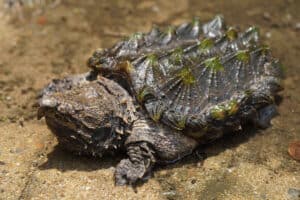
The alligator snapping turtle is characterized by a black or dark brown colour and a large pointed head. The entire carapace is covered with pronounced spikes, but they aren’t sharp. Even the skin has structures that look like spikes. The tail is similar to the alligator’s, with rough ridge-like points. Young snapping turtles have extremely long tails and rough shells.
It’s the largest turtle in TN with a length of 15 – 30 inches. Snapping turtles consists of three species, two of which are found in Tennessee: the common snapping turtles and alligator snapping turtles. The species lives in muddy rivers with lots of vegetation, particularly rivers that drain in the Gulf of Mexico. The adults hunt in deep rivers, lakes, swamps, bayouts and ponds. The best place to see the alligator snapping turtle is in Mississippi River drainages.
The bottom dweller is best known for an adaptation that lets it lure fish into its mouth. To catch its prey, the adult snapping turtle will rest very still, as if dead, mouth wide open in the depths of a pond for up to an hour. It has a small, bright, worm-like appendage on its tongue that lures passing fish into the mouth. They have a sharp beak, strong jaw, and are extremely aggressive, leaving the prey with no chance. These have even been known to injure and kill other turtles by biting off the head.
The turtle is omnivorous, so they have a wide range of diets including fish, snakes, crayfish, frogs, birds, carrion and vegetation. Younger turtles prefer more vegetation, while large turtles love to ambush larger prey. Snapping turtles do bask on land, but they spend more time in water and will occasionally surface to breathe.
Alligator snapping turtles breed during the spring, then the female leaves the water during late spring or summer to dig a nest and can lay up to 60 leathery eggs in one round. The eggs could hatch after 2.5 – 3.5 months, depending on nest humidity and temperature. Females leave it to the males to care and protect for the hatchlings.
3. Common Musk Turtle
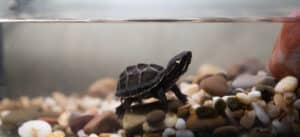
The common musk turtle is native to North America with a usually plain and unmarked shell and skin and a long neck and short legs. The musk has very consistent colours, usually dark brown to black. The shell has a unique feature, though, and that’s the ridge that passes through the entire shell length. Also, the dark head has two colored strips and fleshy barbels on their necks and chins, making it easily distinguishable.
The musk turtle is also known as stinkpots due to the strong defensive odour the turtle excretes from its musk gland, especially when it’s mishandled or threatened. You can easily come across the common musk in many areas of Tennessee but not in central and northeastern areas. The head is vaguely triangular with a pointed snout, sharp beak and a yellow-green stripping that runs from the nose to the neck.
Like many aquatic turtles, the common musk prefers to reside in slow-moving and still water bodies. But in general, you will spot them in rivers with a soft bottom with mud or sand. The tiny turtles grow up to 4.5 inches, which means you can keep them in a small 20-gallon tank. However, ensure there’s a strong filtration system in place because the musk turtle can be pretty messy.
Common musk turtles can feed on both plants and animals, especially at night. You can feed them molluscs, crayfish, tadpoles, insects, aquatic insects, carrion, algae, commercial pellets and vegetation. Their nesting season starts end of May and lasts until August. Females lay about 2 – 5 eggs per clutch, but they do not dig their own nests. Rather, they place the eggs under dead leaves, rotten logs, or stump holes. The eggs have an incubation period of 2 to 3 months, depending on nest temperature.
4. Stripe-necked Musk turtle
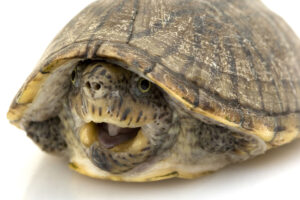
The striped neck turtle is the only species of Loggerhead Musk Turtle in Tennessee, mostly found in the east of the Tennessee River. The small aquatic turtle reaches a maximum length of 5.3 inches and a maximum weight of 203 grams. The carapace is brown to olive-brown and may have small non-distinct black spots bordering the scutes.
Their distinguishing feature is the dark stripes lining the neck and head. The plastron is yellowish with uneven dark brown scutes, while the skin is brown to gray brown. Two fleshy appendages known as barbes can be observed on the chin.
Adult stiped-neck musk turtles spend most of their time in ponds and river bottoms searching for prey and mates. Though they don’t bask frequently, musk turtles have been seen climbing snags to bask a significant distance from water. The species is diurnal and can be seen foraging in the morning.
Little is know about their breeding and reproduction, but it’s thought they lay about 7 eggs. Adults mate in the springs resulting in an egg-laying summer. They can dig nests in loose organic material near slow-moving water. The young ones are thought to hatch between 8 – 6 weeks.
Striped-necked turtles are primarily carnivorous, although they may occasionally eat some plants. Their diet consists of snails, crayfish, molluscs and aquatic insects. Stripe-necked turtles don’t like the handling and will even release a foul-smelling liquid to deter intruders.
5. Eastern Mud Turtle

The Eastern Mud Turtle is a semi-aquatic turtle found in most Tennessee regions, except the TN River drainages and upper Cumberland. Eastern mud turtles are among the smallest turtles globally, growing up to 4 inches and weighing 80 to 265 grams. The mud turtle is the hardest to tell from the rest, but it has a smooth, oval, dark brown or black carapace without keels and patterns. Also, they have a large double-hinged yellowish-brown belly, and dark markings with a pronounced bridge between the plastron and carapace. Young mud turtles have red-orange spots on their plastron, hence the species name Subrubrum.
Only the K. s. subrubrum subspecies of Eastern Mud turtle is found in Tennessee. Still, the other two subspecies Florida and Mississippi Mud turtle, can hybridize with the Eastern Mud turtle along the Mississippi River.
The small turtles can be found shallow swamps and bogs or any other slow-moving waters. They are among the most common pet turtles in Tennessee because they have minimal requirements and care needed. 25-40 gallons is adequate for these, but a powerful filtration system is a must. You can keep the water temperature around 750F.
These turtles are omnivorous, so they can eat anything from molluscs, snails, worms, snails and clams. You need to ensure an adequate supply of greens too. Commercial diets are also a good addition to the diet of these Eastern guys. It’s normal for Eastern Mud Turtles not to bask often.
Nesting begins in May and happens all through to the end of July. Eastern mud turtles incubate much longer than most turtles, taking 90 – 110 days, but the hatchlings stay in the nest until the spring or winter the following year.
6. Three-toed Box turtle
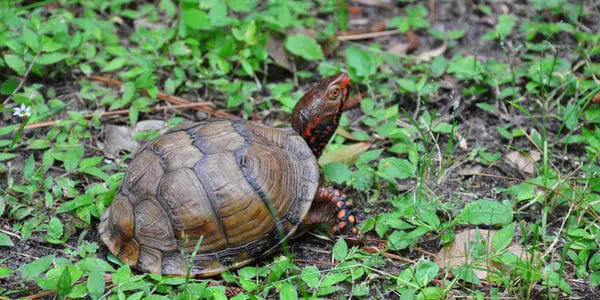
Named for having three toes at its feet, the three-toed Box Turtle can be anywhere from gray to olive with no distinct colouration on it. The three-toed box can live for 50 to 100 years.
The upper part of its shell is doom shaped with two colours; one that covers the top and a different colour on the sides. Most box turtles grow to a length of 5 to 7 inches. Unlike most turtles that live more in water, the Three-Toed Box Turtle prefers land, the reason you find them in open woodlands and grasslands.
These omnivores feed on anything they can find from meats, berries, insects, salamanders, birds, eggs, snakes and all kinds of vegetation. While adults tend to be herbivorous, the young are primarily carnivores until they reach 5 – 6 years. These turtles prefer to roam around in search of food, but they also thrive in an indoor environments. However, they will need roomier enclosures to walk around. Ensure you don’t leave holes in the enclosure because these small creatures stand little chance against raccoons and other predators.
The mating season begins in the spring and goes on throughout the summer to October. Nesting occurs between May and July, with most nests dug in the sand. They lay 3-8 eggs, and temperature determines the sex of the offspring. Nesting between 22-27 degrees tends to be male while anything above breed female.
Sadly, the conservation status in Tennessee is worrying and shows just how close these fellows are to extinction. This can be attributed to hunters who use them for food, medicine, and burial. Fortunately, three-toed box turtles are very popular as pets.
7. Eastern River Cooter
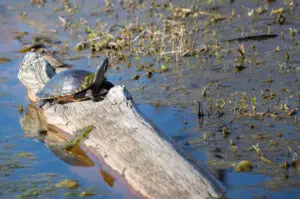
Eastern River Cooter is one of the most common freshwater turtles found in all major water systems in Tennessee, including rivers and lakes. It exhibits a brown to nearly dark carapace and a reticulate pattern of orange-yellow lines. The scutes have wide yellow borders and donut-shaped markings under the marginal plates. The River Cooter has numerous yellow stripes on the neck, chin and head. Adult males have longer claws on the front hinds and thicker and longer tails than females. The average length of an adult River Cooter is between 9 and 12 inches.
The River Cooters prefer areas with lots of aquatic vegetation and rocky bottoms because they mostly feed on plants. They feed on eelgrass, algae, pondweed, crayfish, snails and tadpoles. They can be often spotted in logs in groups and sometimes stacked on top of one another. They are enthusiastic hunters who will roam around to trap insects and worms before going back to the water to eat them.
Speaking of breeding, the female River Cooter is extremely selective. Males will have to do some sort of dance to try and seduce the female. They do this by vibrating their long nails and waving their arms close to the female face. Often, she will turn down potential mates until she meets her approval.
Mating occurs during the spring, after which the females dig nests in sands close to the rivers and deposit 9 to 29 eggs. Hatchlings emerge after about 2-3 months but will remain in the nest until spring.
Although the population numbers of the Eastern River Scooter have declined, the species is still locally abundant.
8. False Map Turtles
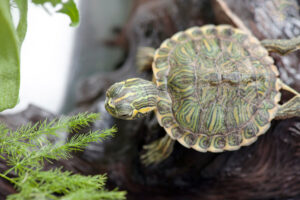
False Map Turtle gets its name from the map-like turns on its back formed by light yellow lines, though obscure on adult turtles. Old female False Map Turtles features dark blotches on their back and plastron. The turtle also has a vertebral keel on its back that is quite noticeable even in adults. Besides, the turtle has serrated margins on the rear.
The false map turtle has other distinguishing features from all other map turtles. The plastron contains black swirls and lines and is dull yellow. In addition, the head and limbs are dark olive or black. What’s more, the no spots or blotches on the head, unlike other turtle species.
The false map turtles are mainly found in Missouri and Mississippi Rivers in Iowa. The species extend to Iowa in the west and along the big streams from the Mississippi. In River Missouri, the turtles do not conquer that far from the west as they seem more restricted.
Compared to other Iowa turtles in Tennessee, false map turtles have a shorter active season, mainly from April to September. The species are entirely aquatic and never roam away from water, although they forage a short time during the day. The false map turtle basks on anything away from shore and above the water in the deep sea. Fallen trees, as well as Snags, provide perfect basking areas.
A False map turtle feeds on various aquatic insects. Aquatic plants, crayfish and fish, particularly dead fish, form a good dish for this turtle species.
You should always approach quietly and slowly if you want to view these beautiful creatures since they are very chary.
9. Northern Map Turtle
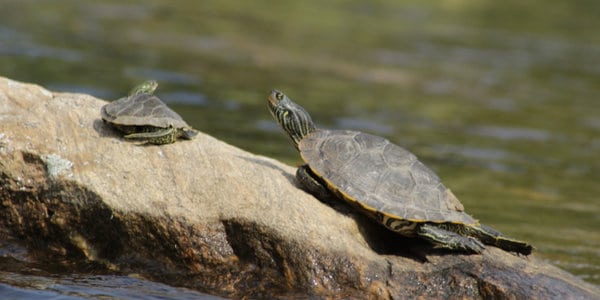
Northern Map Turtles have dark brown or olive green shells characterized by yellow marking like contours in a map. However, the markings on the carapace tend to fade with age and can only be seen when the shell is wet. It’s the distinct small yellow spots behind the eyes that differentiate this turtle from other subspecies. Theyy also have yellow lines over their necks, heads and limps. The plastron is light yellow with a central dark blotch that also fades with age.
Northern Map turtles are very common in east Tennessee rivers and the Cumberland River in central regions. They can often be seen basking but not far away from the water. It’s safe to say that the Nothern map turtles are social, especially during the day. However, they are quite shy and will slip in water and hide at first sight of danger.
Males grow up to 6.5 inches in length, while females can grow as long as 11 inches. Males have longer and thicker tails compared to females but with broader heads than the males. This is associated with feeding. Males also have a narrower upper shell than females.
Like most aquatic turtles, the northern map turtle likes to feed inside water and will prefer meats. Adult females have wide heads and stronger jaws with a broad alveolar to feed on molluscs, crayfish and insects. Adult males have much narrower heads which they use to feed on smaller insects and molluscs.
The Nothern Map Turtle goes to hibernation around November all the way to April. They will spend most of the time underwater, especially when there’s ice. Their nesting periods run from May to July, where the females choose unshaded well-drained areas to nest. They lay between 6 to 20 eggs, with the incubation lasting from 50 to 70 days.
10. Mississippi Map Turtle
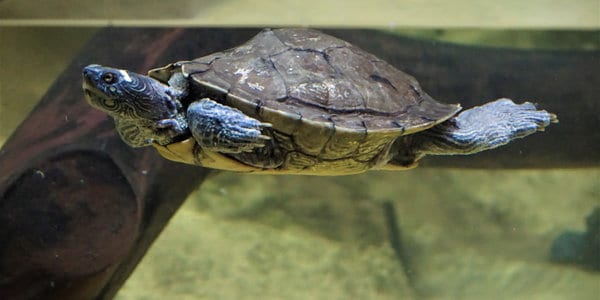
Mississippi map turtles belong to the same subspecies as false map turtles and are common along the Tennessee and Mississippi rivers. Their dark shells are often black or brown with yellow markings that resemble contours. Mississippi map turtles have a series of black-tipped keels that run the entire length of their shells and are considerably sharp.
Mississippi map turtles can coexist in a community of turtles; however, the females grow twice as big as the males, so you should avoid keeping a large number of females together. This variety of aquatic turtle requires plenty of swimming space and gentle turbulent water flow to mimic their natural habitat. A female Mississippi turtle requires a 125-gallon tank, and a male can typically do well in a 75-gallon fish tank. The tank should have a beach of rocks and gravel on one side to provide your turtles with a basking area.
This species is considerably sensitive to water quality and quickly gets afflicted by a number of infections if left in dirty water for too long. Ensure that all the water flowing into the enclosure is filtered constantly to clear the water and eliminate odours.
Mississippi map turtles are more active when the temperature is kept at around 85 degrees F, which also improves their appetite. Avoid exposing the turtles to temperatures below 60 degrees as they will become lethargic and go into hibernation. If your turtles are constantly housed indoors, you will need to provide full-spectrum UVA/UVB lighting for at least 12 hours a day all year round to meet their natural sunlight requirements.
Mississippi map turtles are omnivores and often feed while swimming. Supplement their aquatic turtle pellets with fresh leafy vegetables and plants such as dandelion greens, romaine, and fresh parsley. Mississippi turtles have an insatiable appetite for insects, fish, and crustaceans but avoid feeding them fatty fish.
11. Ouachita Map Turtle

Formerly classified as a subspecies of False Map Turtle, the Ouachita map turtle occurs in TN and occurs in one subspecies. The medium-sized turtle grows to 3.5-6.5 inches while females can grow to as long as 10.25 inches. You can tell this species off using a distinct large, yellowish patch behind the eye that’s either rectangular or oval. The carapace is olive-green to brown, and the scutes have large smudges and yellow lines that appear like waterways on a map.
The backbone of the shell features a blunt keel, and the back end appears to be serrated. The limbs, head and neck are dark green with rising yellow lines. The plastron is bright yellow with gray strip along the scutes border. The skin of the Ouachita’s map turtle skin is covered with thin yellow-white lines.
Surprisingly, the males are primarily carnivorous, while females are herbivores. Males will feed on small aquatic creatures like molluscs, crayfish, fish and insects, while females consume algae and other aquatic plants. You can easily come across these turtles in large rivers and lakes with plenty of vegetation and rocks.
Courtship and mating are likely to occur inside water in the spring, where females lay 6-15 eggs per clutch in the summer. Nesting is mainly on sandbars and soils with excellent drainage. Hatchlings emerge later on in the summer and could also hatch in the fall. The best places to watch the Ouachita Map turtle is in the main channels and tributaries of the TN Rivers and Mississippi.
12. Cumberland Slider
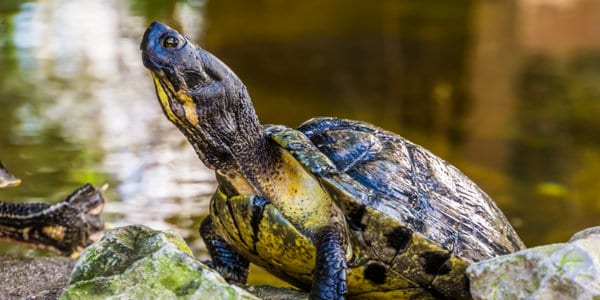
A cousin to both the Red-eared and Yellow-bellied sliders, Cumberland sliders are common in the southeastern US. In Tennessee, they are commonly found around the Tennessee and Cumberland rivers. The shell ranges from brown to olive green with yellow markings and distinct yellow, orange or red stripes behind the eyes. The skin colour resembles the skin’s and can range from brown to black with yellow stripes.
The turtle is among the most popular pet turtle species because they are easy to care for and docile. The semi-aquatic turtle prefers to feed in the water, so an aquatic set-up is necessary to keep this American turtle. A Cumberland male slider will need a 75-gallon tank, while females might need a 125-gallon tank with effective filtration and temperatures over 75 degrees Fahrenheit.
Although these are known omnivores, the young are predominantly carnivores, while adults are mainly herbivores. Cumberland sliders will feed on worms, molluscs, crayfish, insects, fish, algae, tadpoles and aquatic vegetation. Like pets, you can feed the shrimp, bloodwork, fish, locust, earthworms and snails. Vegetables include romaine lettuce, duckweed, shredded carrot, dandelion leaves, spinach and aquatic plants.
Breeding happens during the spring, winter and fall months, after which the females lay 6 to 15 eggs per clutch, with most females laying in two seasons annually. However, females can go to extreme lengths to nest, the reason they may get run over by cars when crossing streets and roads. Common predators for the Cumberland slider include wading birds, alligators, raccoons, marsupial, skunks and coyotes.
13. Spiny Softshell Turtle
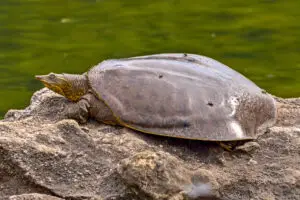
Did you know that the Spiny Softshell turtle hibernates nearly half a year in the mud? This Tennesse turtle is an incredible species with even more amazing features. You can distinguish it by just looking at its carapace. Unlike other turtles, the Spiny Softshell turtle has a soft, rubbery and flat shell. The ends of the carapace are malleable with small spines, while the male turtles have more spines than the females.
While an adult male turtle can be around 5-10 inches, females are bigger and have a length of about 7-19 inches. The turtles have fully webbed feet, and the nose is elongated like that of a pig. This helps them swim since most of their life is spent in water.
Ranging from crayfish, aquatic insects and fish, a spiny softshell turtle can eat almost entirely anything that fits his mouth. He burry himself under the mud at the bottom of the river, only his head sticking out to catch any prey that passes by.
Spiny softshell turtle species are spread throughout the US in most states such as Tennessee, Wisconsin, Minnesota, the central-eastern US to the far south of Mexico. The turtles’ inhabitants include ponds, rivers, lakes, streams with a muddy or sandy bottom and somewhat little vegetation.
Male turtles court female turtle by nudging at her head while swimming. The male will swim above the female with her approval, but he won’t clasp with his claws as other species does.
The spiny softshell turtle generally breeds in May. The females lay about 4-38 eggs in loose soil or sandbars and hatch around August or September. In the wild, the spiny softshell turtle can live up to 50 years.
Though the Spinysoftshell turtles are not listed as endangered in the US, they face some threats, including chemical pollution and habit destruction.
14. Smooth Softshell
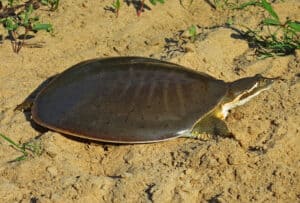
The Smooth softshell is so similar to the more widespread Spiny softshell, but the difference is that the spiny has little spines at the front of the carapace. You can easily see these guys around the Reelfoot Lake near the northern half of the TN River in West Tennessee. The freshwater turtle has a smooth and leathery carapace covered by skin instead of scutes as in other turtle species. Its plastron is gray or white with no markings.
The females are larger than males and are usually olive-coloured or brown with uneven dark brown blotches. On the other hand, males have thicker tails than their female counterparts, although the hind claws are shorter than the females’. The most common way to spot smooth softshell is to look for their long snout poking out of water for air.
These are the most aquatic of softshells as they are dubbed as “swimmers.” They can spend more time in the water thanks to their long necks and snout. They prefer muddy waters where they can bury in the sand substrate at the bottom of the pond so that their snout barely comes over the surface. Besides, the skin covering the shell facilitates gas exchange, another reason they stay submerged for longer periods.
They utilize their long necks when hunting the prey by waiting for them to pass near them. Besides, these turtles are extremely fast swimmers due to their flattened bodies and lightweight shells. Their prey includes crayfish, frogs, insects and worms.
Breeding occurs in the spring, which is followed by an egg-laying summer. The females lay 4 – 33 brittle eggs and then bury them in river islands and sand. Hatchlings emerge after 2 months of nesting. The smooth softshell turtles are not considered endangered but face threats from habitat degradation.
15. Red Eared Slider
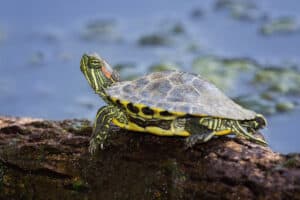
The red-eared slider is native to Tennessee and most of the southern united states. This is among the most invasive turtle species due to its semiaquatic survival skills and outcompeting native species.
Red-Eared Sliders females can grow up to 6 to 8 inches in length while the males can grow up to 16 inches. These turtles typically survive for around 20 to 30 years, but their life expectancy drops when kept in captivity due to changes in the living environment. Their skin is covered in yellow stripes, contrast the brown, olive green to black colour of the rest of the skin and shell.
The Red-Eared Slider is almost entirely aquatic and should be housed in a fish tank equipped with a sunbathing gravel beach. Their small size makes them highly recommendable as they require low maintenance costs.
A 55-gallon tank should be enough to house a single red-eared slider. Make sure that the tank is hooked up to a filtration system to keep the water clean. They also prefer temperatures ranging between 76 to 84 degrees F.
When in captivity, the Red-Eared Slider survives on an omnivorous diet consisting of vegetables, leafy greens, insects, small fish, and turtle pellets. Keep in mind that this species of turtles are considered active swimmers, and you will need to get a tank designed to have a lot of space for them to explore.
Red-Eared sliders mate around march to July and female keeps the eggs warm during the incubation stage which take around 59 to 112 days. The species have a high hatchability rate, making it much easier for them to survive and invade other species in new environments.
16. Yellow-Bellied Slider
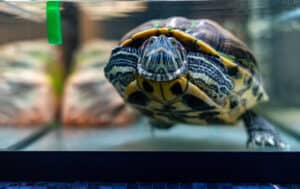
Yellow-Bellied Sliders are commonly found in southeastern Tennessee in rivers and wetlands. Their name comes from their yellow plastrons and the numerous yellow markings on their skin. Besides, they are yellow patches behind their eyes, and their shell colour can range from dark brown to yellow.
These turtles are the largest pond slider subspecies and could need a tank larger than 70 -150 gallons depending on the gender. Adequate heating and filtration is also important, and water temperature should range from 76 to 84 degrees Fahrenheit. As far as turtles go, it’s fairly easy to care for a yellow-bellied turtle.
Like other sliders, they are diurnal, meaning they are likely to eat and bask during the day. They can be seen in large groups, usually basking. Although they are social, Yellow-Bellied Sliders are shy and dislike beinghandled. When they feel threatened, they can bite.
Yellow-bellied sliders are omnivores, so they should get a wide range of animal and plant-based food. Ensure to include greens like dandelion, fresh parsley, and dandelion leaves in their diet. You can also provide them with freeze-dried shrimp and apple pieces. However, young turtles tends to feed more on protein in the early stage of development. Some things they like to eat include snails, amphibian larvae, fish, insects and small crustaceans.
Adults begin mating in the water during the spring and could carry on into fall. After mating, females leave the water and find a suitable place to nest and lay 4-22 eggs. As pets, ensure you don’t touch or turn the eggs you found otherwise, you might kill the embryo. The eggs hatch in later summer, but the young remain in the nest until spring.
17. Southern Painted Turtle
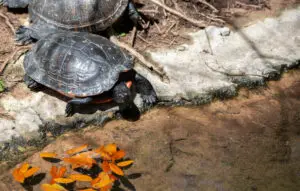
Southern painted turtles are some of the most widely spread aquatic turtles native to Tennessee. This variety lives in freshwaters under slow-moving conditions. The males are smaller, and the females can grow up to 10 inches long. The dark and smooth top shell without a ridge makes it much easy to identify this variety.
Southern painted turtles survive on an omnivorous diet ranging from aquatic vegetation to algae and small insects and fish. Under captivity, you should supplement their diet with crustaceans and fresh vegetables.
This variety of aquatic turtles mates during spring and autumn, and their hatchlings or eggs are often consumed by snakes and rodents. However, the females can live for up to 16 years, allowing the entire population to breed during the warm months making this one of the most widespread native turtles from North America. Under proper husbandry and healthy living conditions, these turtles can survive up to 50years in captivity.
Southern painted spend most of their day basking, so you will need to provide UVB lighting and a heating lamp if you plan to keep the turtles in captivity. Temperatures of around 80 to 90 degrees F are conducive, and the water temperature should be kept in the low 70s F. ensure that the water is at least 12 inches deep to give the southern painted turtle enough room to swim.
Female southern painted turtles require at least 75 gallons in terms of tank size, while the males can do with around 40 gallons. You should also provide underwater hiding places by stacking up sizeable rocks which mimic the turtle’s natural environment.
Southern painted turtles can survive in a community habitat with other species such as map turtles and cooters. Females can get aggressive and should not be overcrowded as they tend to bite each other when provoked.
18. Eastern Box Turtle

Did you know after a successful breeding, a female Eastern box turtle may lay fecund eggs for up to four years? Continue reading to learn more interesting facts about this turtle commonly seen turtle species.
Its carapace covers most of his body and is dome-shaped, with furrows and ridges that tend to develop with age. The turtle has slightly webbed toes, and the upper part of the mouth is slightly hooked. The eastern box turtle is about 5-6 inches long on average.
Several subspecies of this turtle have different colouration. Some have olive-brown shells plus yellow decorative patterns, while others have brown shells.
Whereas yellow patterns on dark faces and feet are common for most eastern box turtles, some reptiles lack yellow markings completely.
These turtle species will feed almost on anything bearing the fact that they are omnivores. They will eat insects, flowers, amphibians, roots, eggs and berries. Young Eastern boxes are a bit more carnivorous compared to adults. They hunt in rivers and ponds for food while the adults mainly feed on land.
Eastern box turtles are mainly found near meadows, woodlands, fields and pools in Tennessee and half of the US Though innate to the eastern United States, they are also seen in some other states in the US due to their popularity. Besides, their keepers release them to the wild if they move or no longer need them.
In the northern, including Tennessee, the eastern box turtle hibernates, burrowing itself in stump holes, mammal burrows and stream bottoms. They also hibernate in the same space many a time. When threatened, box turtles will retract their four limbs into their shell, enabling them to stay away from danger.
The eastern box turtle copulates between April and October, with nesting taking place from May through July. Yearly, a box turtle mostly has one clutch, with each clutch having 2-8 eggs. The incubation typically lasts three months, though it depends on the soil’s moisture and temperature.
Just like in other turtle species, the sex of the turtles’ hatchlings is determined by the temperature of the nests. While warmer nests produce females, cooler nests produce female eastern box turtles. These reptiles reach adulthood at 10-20 years old. Interestingly, they can live for more than a century.
Conclusion
This wraps up our list of native Tenessee turtle species, including their basic facts, diet, habitat, and where to find them in Tennessee. If you’re looking to pet one of these turtles, then this list should guide you on which species is right for you.
Turtles form a special part of our ecosystem and are fun to observe. Next time you’re paddling along the Harpeth River, make sure to count how many you can see. Together, we can protect these turtles and keep them healthy. Note that there are a few more species we have not covered in this guide.
If you have any questions about something you didn’t find in this article, talk to us, and we will give you answers as soon as possible.
Interested to learn more about Turtles In Oklahoma (17 Species Guide)